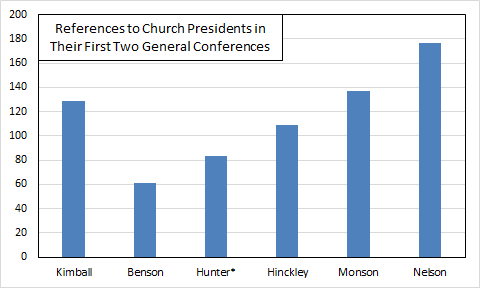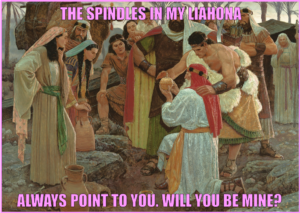Note: This post is straight-up navel gazing. Consider yourself warned.
This month marks 13 years since I wrote my first post at ZD. That post was about asking for change in the Church. If you think I’ve been blogging about the same thing over and over for a long time, you’re pretty much right.
One thing that I think has changed in my blogging is that over time, I’ve shifted from more blogging about numbers-related stuff to more blogging that’s just plain silliness. I definitely still enjoy looking at Mormon (or Mormon-adjacent) data and trying to find an interesting pattern in it to write about. But I guess I’ve found that I also very much enjoy writing goofy parodies of Mormon stuff, or rewriting things to make them Mormon-ish. And silly blogging has the added benefit of being much less labor-intensive than stats blogging is. Rather than spending potentially dozens of hours on a post, I can spend maybe one or two. Also, as much as I try to make the numbers-based stuff approachable, I suspect that silly blogging has the potential to connect with more people, as humor is more generally shared than a love of numbers is.
The larger context of ZD and the Bloggernacle have also changed. I think when I first started blogging, after my sisters and their friends had started the blog months before, I was a little more intimidated by my surroundings, both on this blog and on the Bloggernacle more generally. To fit in well, I wanted to say important and well-thought-out things, and working with numbers felt like it gave me the chance to make something I wrote important and well-thought-out, as I’m often better with data than I am with prose. In contrast to those first few years, now that ZD has been around a while, our place in the Bloggernacle is pretty firmly established as decidedly heretical backwater. We’re also much quieter than we used to be, with many of us bloggers moving on to Heavenly Mother status (although I hold out hope that at least some of those moves might yet be temporary). In this context, I feel more comfortable that the hundreds dozens of readers who are still here (thank you for sticking with us!) kind of know what to expect, and have made peace with our quirks. So I’m more willing to let my silliness show, and to dash off a quick goofy post and put it up than I ever would have been in our earlier days.
But let’s look at the data, shall we? I’ve written 243 posts in 13 years, or about one and a half a month. In one way, that feels like not very many, as I suspect that it’s no more than a month or two’s work for a serious blogger like Ardis. But in another way, it feels like a ton, just because there have been so many posts that I thought about and agonized over and rewrote so many times.
I went back and put all of them into one of four categories: numbers, silly, other church, and other non-church. Of the 243, 90 (37%) fell into numbers, 49 (20%) into silly, 96 (40%) into other church, and 8 (3%) into other non-church. So I’ve written almost twice as many numbers-based posts as silly posts. But in the past few years, as I had suspected, I’ve flipped and written more silly posts. Since the beginning of 2017, I’ve written more silly posts (26) than numbers-based (16) or other church (17). Here’s a graph that shows the percentage by type across time.
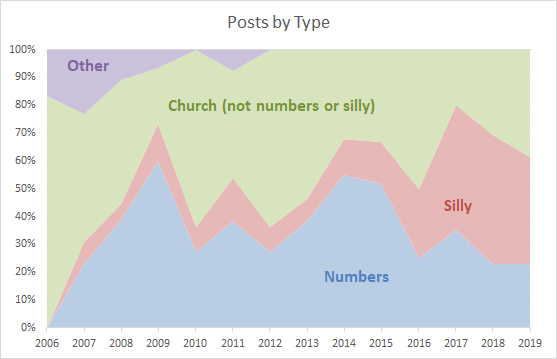
Read More
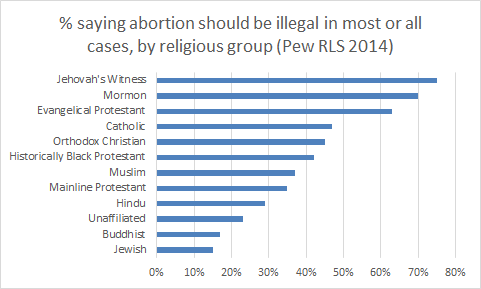 (Note that this is just a graph I made from the Pew graph so that I could sort by percentage rather than by religious group name. If you follow the link in the paragraph above, you’ll find a graph with the same numbers.)
(Note that this is just a graph I made from the Pew graph so that I could sort by percentage rather than by religious group name. If you follow the link in the paragraph above, you’ll find a graph with the same numbers.)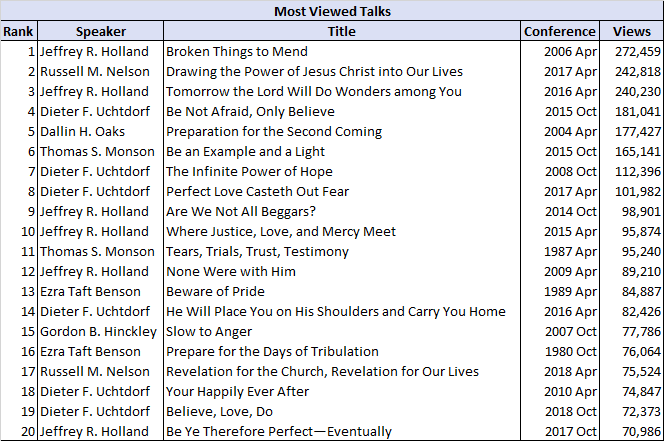

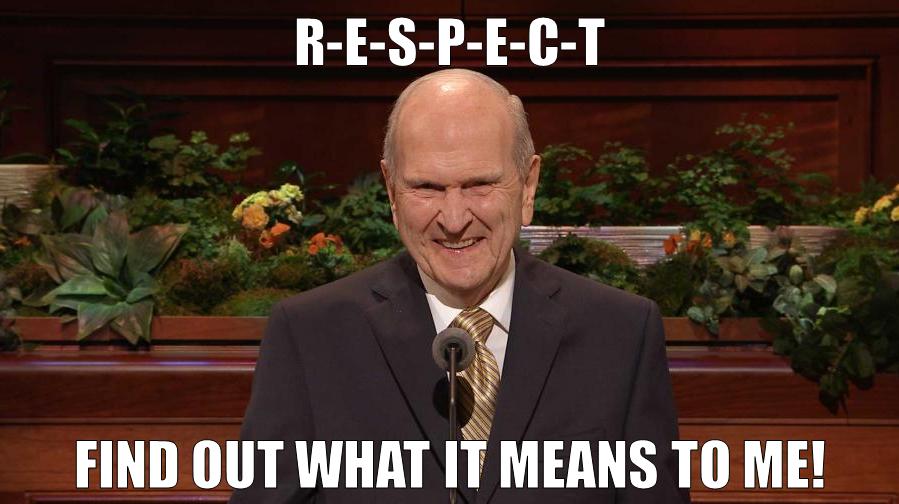
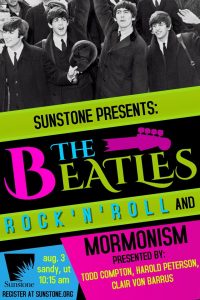




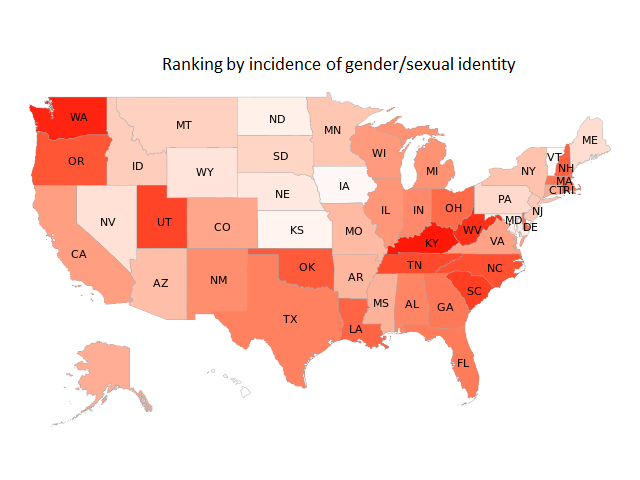

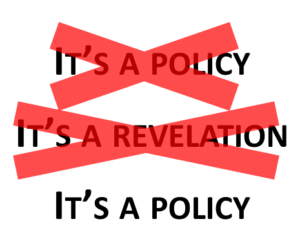 who were hurt during the three and a half years it was in place? Do Church leaders seriously expect us to believe that it was just the will of God that they suffer, but that now God has changed his mind? This change feels similar to the changes made in the endowment ceremony just a couple of months ago. It was great that the hierarchy-imposing structure was reduced, but it was awful that there was not even a mention of the pain that had been caused to so many women by the the “hearken” and “obey” covenants and the resulting power differential they were put under.
who were hurt during the three and a half years it was in place? Do Church leaders seriously expect us to believe that it was just the will of God that they suffer, but that now God has changed his mind? This change feels similar to the changes made in the endowment ceremony just a couple of months ago. It was great that the hierarchy-imposing structure was reduced, but it was awful that there was not even a mention of the pain that had been caused to so many women by the the “hearken” and “obey” covenants and the resulting power differential they were put under. hed our bishop and told him he wanted to do just one year and do a service mission. Happily, our bishop was on board, and he’s been very supportive through the whole process. The process of getting my son officially called was long and drawn out because the way the Church was handling service missions was in the middle of a major change when my son went to the bishop. So it took a while, but he’s finally official and doing his work. He seems to be enjoying it.
hed our bishop and told him he wanted to do just one year and do a service mission. Happily, our bishop was on board, and he’s been very supportive through the whole process. The process of getting my son officially called was long and drawn out because the way the Church was handling service missions was in the middle of a major change when my son went to the bishop. So it took a while, but he’s finally official and doing his work. He seems to be enjoying it.